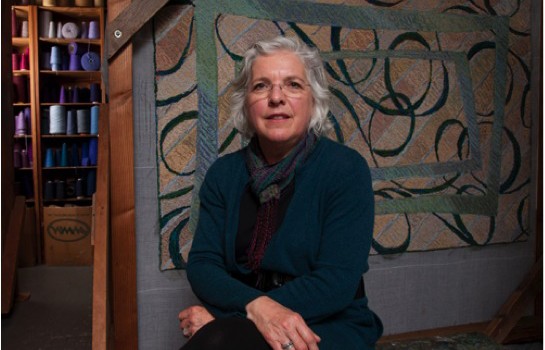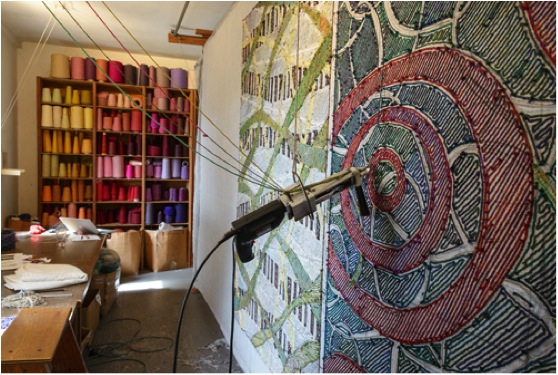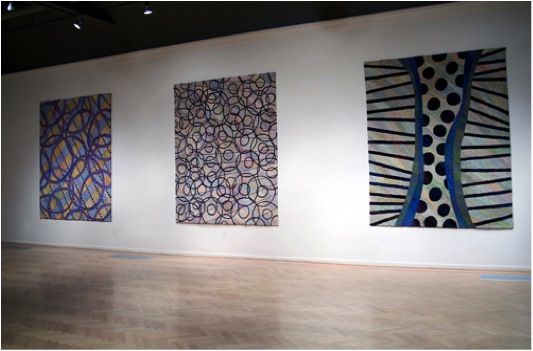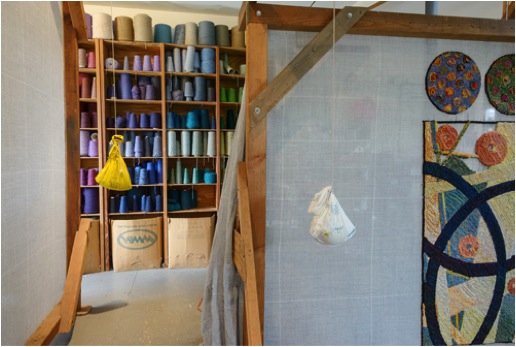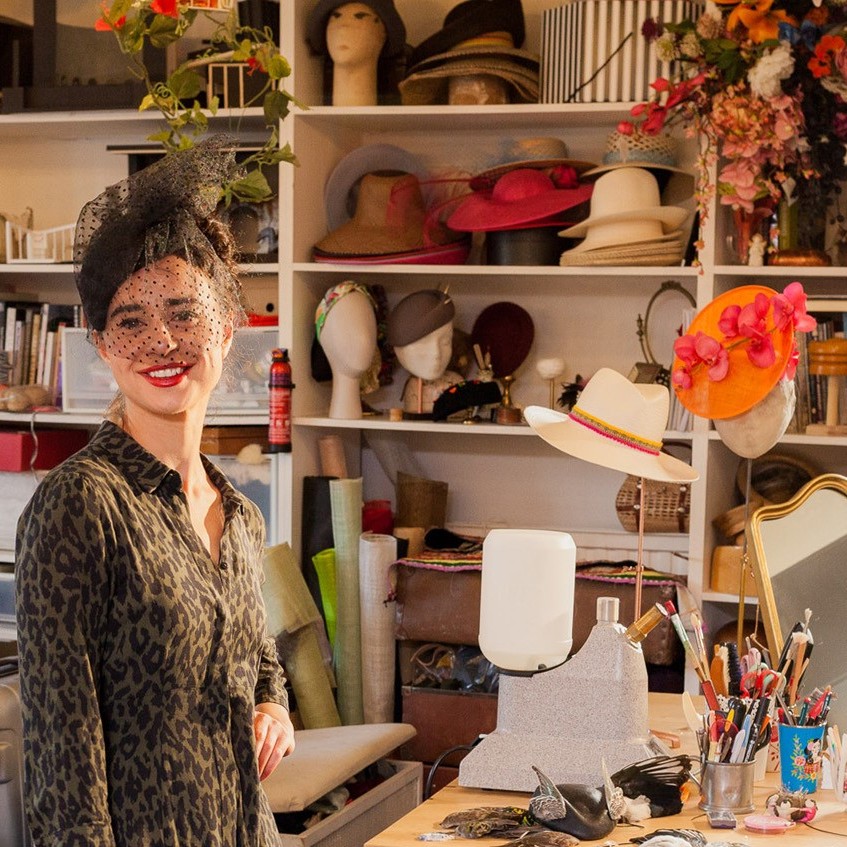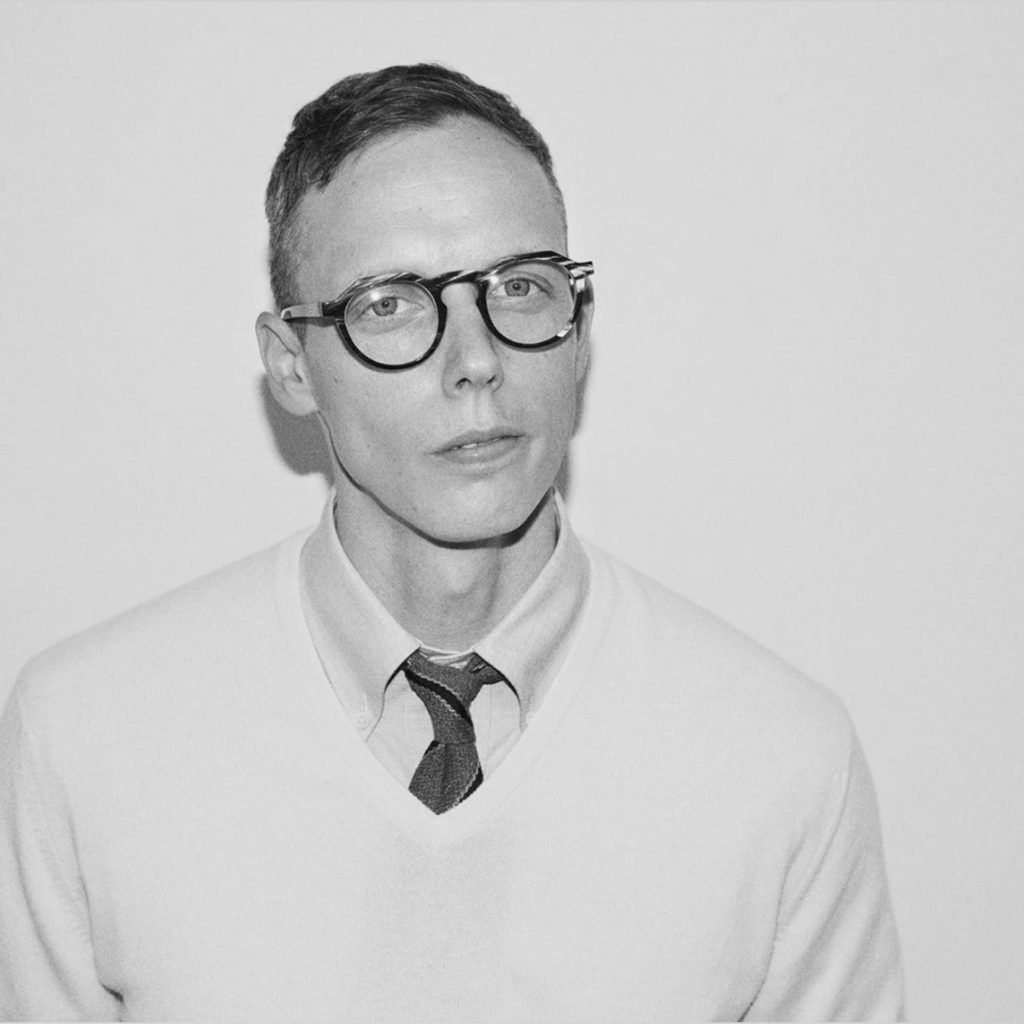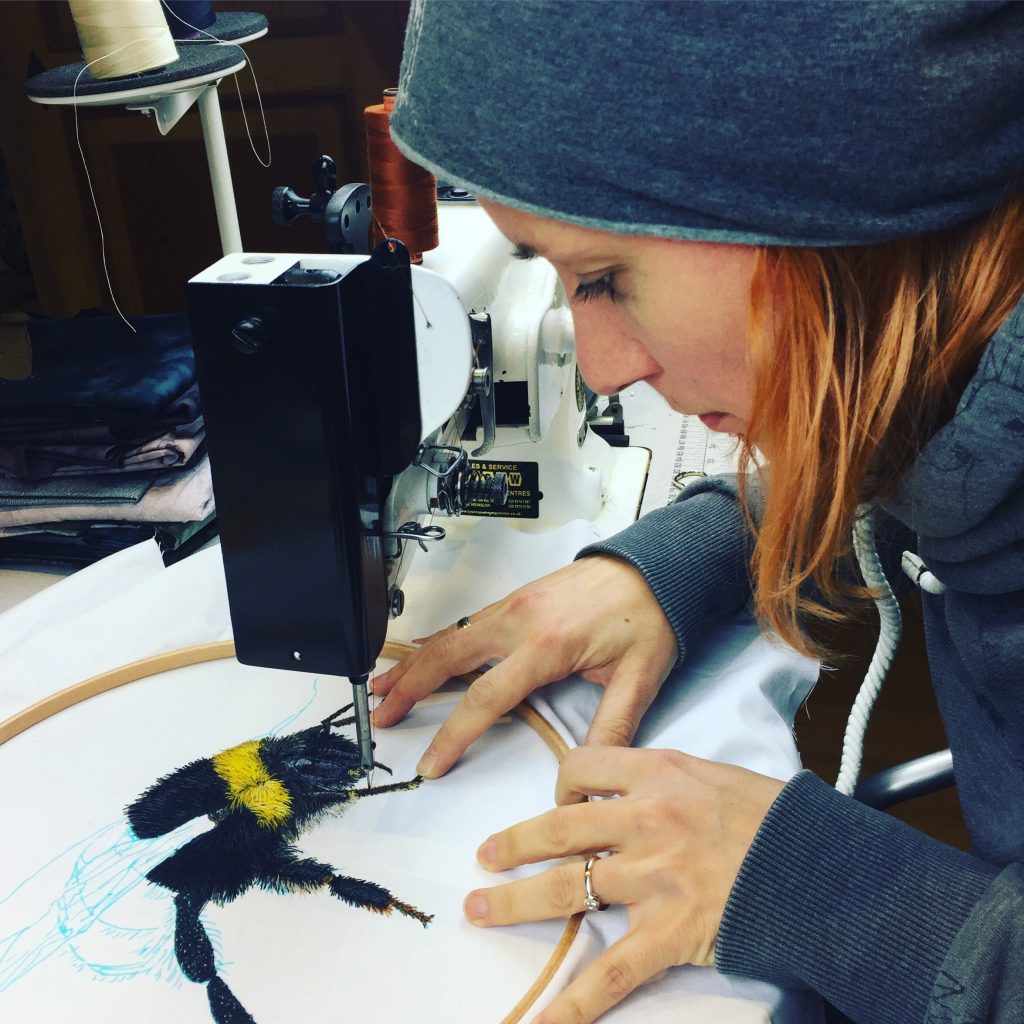Meg Little Rug Maker - Rhode Island, USA.
Explain the importance your move to Cornwall, in the UK, was to the development of your art in rug making?
I moved to Cornwall in 1984 right after getting my Masters Degree from Rhode Island School of Design. I walked into Plymouth College of Art and Design and introduced myself to the Crafts faculty and I eventually taught there. One of the lecturers told me that there was another American weaver living nearby: Grace Eckhert. She was a tapestry weaver who was beginning to experiment with hand tufting. We became friends and she let me use her tufter while she was on holiday. I had taught myself to weave in high school and have two textile degrees but in those years I’d also started to paint. Painting is more immediate than weaving and using the tufter gave me the same freedom as painting but in my preferred medium. It was a revelation. We spent 6 years in Cornwall and I do feel as if I also absorbed some of the design sensibilities of other UK artists.
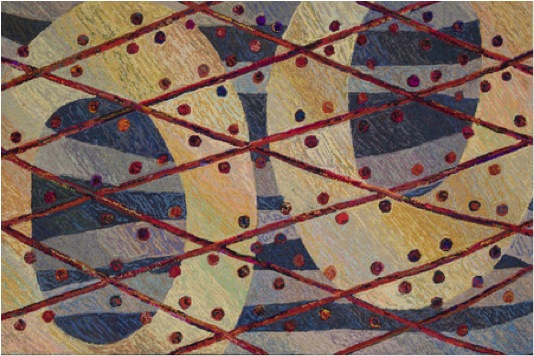
‘Sudd’
Can you discuss the relationship you see between rug making and tapestry?
In both traditional tapestry and woven pile rugs, one makes the web of the cloth while also laying in the design which covers up the web. Hand tufting is actually more like embroidery; one decorates the previously woven web. This means that the design is not laid in on a grid and is free of that underlying structure. Weaving is a very linear process and any design gets built in that way. With hand tufting that constraint is lifted.
Explain the actual mechanical process of tufting, as you do it?
Hand tufting is the way that commercial area rugs are made if they aren’t woven. My tufter is electric and has two hollow needles that the yarns slide between. The top needle has a point that spreads the web of a backing cloth which is stretched tight on a frame, and the bottom needle has a tongue that shoots the yarn into that space. In front of the needles is a foot like on a sewing machine that helps advance the tufter forward. The yarn is shot into the cloth in a continuous loop following the direction of the foot.
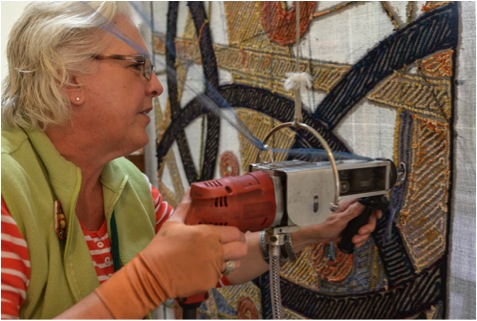
Meg at work in her studio
Discuss how this process has allowed you to use textiles as your paint brush?
The cloth can be filled in with whatever gesture one likes. I personally use a forty-five degree angle to fill in for the most part, which is similar to the way I sketch. Although the process is nonlinear it differs from painting in that the details are applied first and the background goes in last. And unlike weaving, there is the possibility to change elements after they have been layer in which I couldn’t do with my weaving.
The process is very similar to the French Tapestry method – you work from the back. Can you show how the work looks from both sides, how you manage to work “back to front” and why it is done this way?
Working from the back is dictated by the technology.
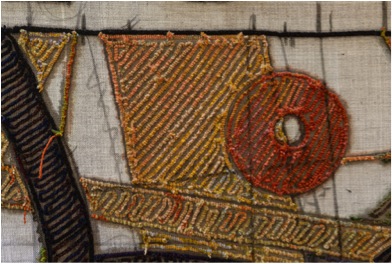
Back of the work
I always reverse my drawings so that the front of the rug is true and I tend to run around to the front frequently to see how things are progressing.
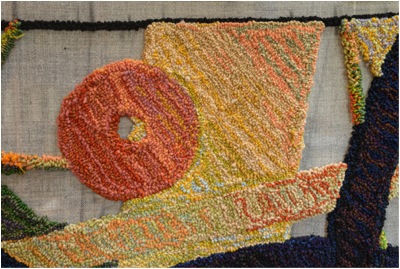
Front of the work
You work on a horizontal loom and not a vertical loom. Can you explain why?
They aren’t woven- no loom. I work upright so that I can get to the middle of the rugs and so I can see the front easily. The tufter really couldn’t be used any other way.
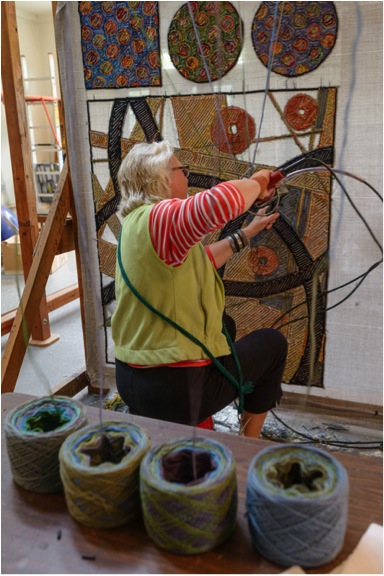
Meg at work in her studio
What type of yarn do you use and why?
I use 2 and 3 ply rug wools made specifically for carpets and rugs. I mix all the yarns in very complex color combinations blending four balls of yarn together in the tufter. Each ball has a different combination of related yarns, sometimes with some very surprising “wild cards”. As a former weaver I can never resist a complex optical color mix- more is more! Each color mix has about twenty-five different yarns in it.
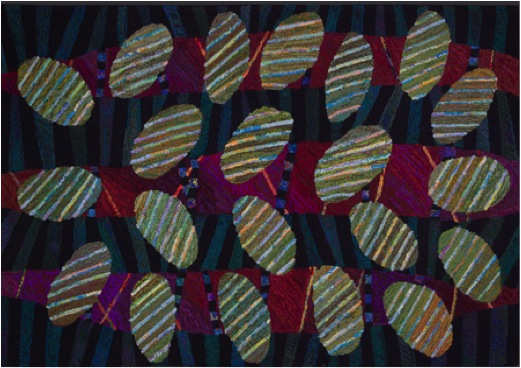
‘Arborvitae’
How about the dying of the yarn, do you dye or purchase pre dyed yarn?
All the yarn is commercially spun and dyed for the carpet industry. Hand tufting is an industrial process and I follow industry standards in making my work. I may make them myself but the rugs are definitely meant to be walked on.
Discuss the limitations of size in your work?
I can make any size rug up to 15’ x 20’. The cloth that I buy from Germany for hand tufting comes 17 1/2’ wide so one dimension needs to be 15’ or smaller. I put a cap at 15’ x 20’- that seemed a good place to draw the line. I’ve made one rug that big and it was a beast! I’ve made lots of big rugs, including round rugs up to 10’ diameter and hall runners as long as 25’. Recently I had an exhibition of only room sized rugs. It was wonderful to see them on such a grand scale.
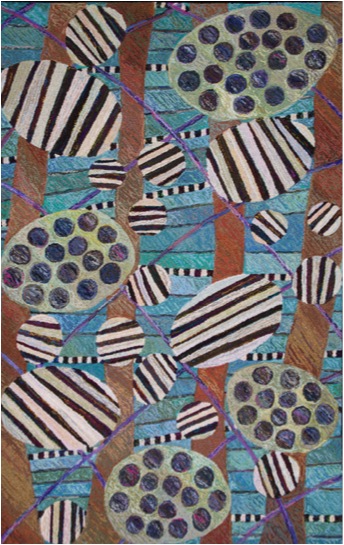 ‘Paradise’
‘Paradise’
Expand on how you are now constructing the “whole” rather than working a design on the background.
I came to hand tufting with very little idea of what to “put on” a rug. My previous weavings were minimal sculptural pieces although very concerned with color. I had very little recent experience with pattern although I’d been apprenticed to an ecclesiastical embroiderer before going to Tyler School of Art in Philadelphia. As I found my way, I discovered that through every culture and across all time there’s a common pattern language. The building blocks are the dot, the line, the square, the circle. I was delighted to find examples from every corner of the world and I have explored all the permutations. I love that I can be a part of a long continuation of makers and that my work reflects an ancient decorative tradition or some other part of the world.
For the past dozen years I’ve only been interested in the expressive geometric. As I mined the various combinations and re-combinations of these shapes I became aware that even though my designs were constantly evolving that one thing hadn’t changed. It goes back to the idea of embellishing the backing cloth. I usually took my wonderful jazzy circles, stripes etcetera and put them on some kind of mostly static background. I don’t necessarily think of “decorative” as a dirty word, but I did recognize eventually that there was something missing. If you think of the way music is layered, it was as if the bottom notes were missing. After that thought I began to demand more of the backgrounds. I didn’t wish for the rugs to become more pictorial, I just wanted the whole band instead of the trio. It gave me endless possibilities for the good old circle, square, spot and stripe to meet up in new and surprising ways.

‘Taiga’
Some of your rugs have text – how and when do you use text and why?
I’ve been using text off and on since the beginning. It’s a challenge; the letters are all put in backwards and also sometimes upside down. My interest comes from an admiration for the Bayeaux Tapestry which has written commentary and for Matisse’s cut outs which sometimes included words. The words are another form of pattern and a narrative too. On the last rug I made with words the only way to read it on the floor is to walk all the way around the edge. This seemed appropriate since the rug is a journey through the four seasons. I’ll let you in on a secret- along with the initial charcoal underdrawing on the backing cloth I sometimes include poems or prayers. You’ll have to get an x-ray to see those!
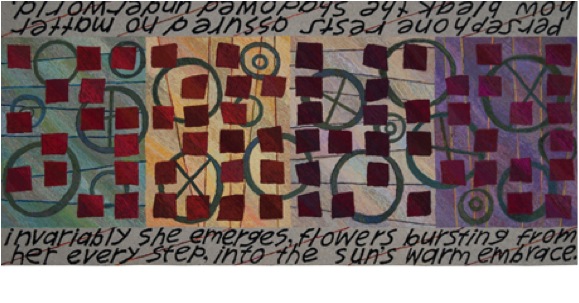
‘Another Year’
Your rugs are designed to be walked on but many are hung. Can you tell us your thoughts on both and also the method you suggest to hang a rug?
I love the way my rugs look on the floor. They get better looking as they get older and they are very luxurious under foot. I know my work has changed a lot from the days when the rugs were just artful to now where they are considered art. The rugs may now have a more profound meaning but they’re made the same way as when they were strictly decorative. So it seems specious to me to say they are “too pretty to walk on”. They are still perfectly functional and why wouldn’t you want something beautiful under your feet?
Hang it or don’t, it’s up to you, but as to hanging- it’s easily done with some carpet tack strip and some tiny nails.
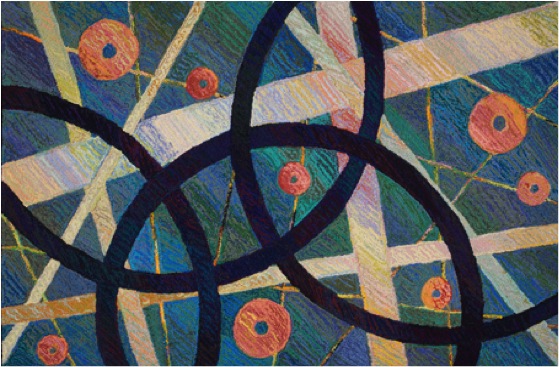
‘Cassiopeia’
You are very interested in having handmade around us. Please expand on this?
When I was writing my Masters thesis I researched why humans spent the extra time to decorate objects for us when it would have been quicker to make plain things. The answer seems to be that there is a human drive to make things “special”, to make the ordinary extraordinary, to celebrate and consecrate our daily lives. Even if you go back to prehistoric times you will find special objects for use including fancy bits of weaving.
People buy my work because it was made by a person and more so, one that they’ve probably met. That’s the kind of object I want in my house and I know I’m not alone.
Do you exhibit?
I exhibit as often as I can. Besides museums and galleries I show my work at high end retail craft shows- about a half dozen a year.
Do you do commissions?
A lot of my work has been commissioned. In the early days there was a lot of tinkering by my clients. Now that the work has such a distinctive look the requests are generally for a special size. I love working with people and seeing their houses if possible. It would be great fun to make a giant piece for the lobby of a building either floor or wall!
Explain the importance of Sketchbooks to the development of your work – from inspiration to finished piece?
I keep at least one sketchbook on the go at any time. I draw in pencil with a yellow No. 2 pencil (for those not in the States- that’s an HB with an eraser). In fact if we can only take one thing on the spaceship to Mars, that’s what I’d take. I draw to scale: an inch to a foot. No color- that comes later when I gather the yarns. I used to feel weird about that until I read that Bonnard would go for a walk, make his pencil sketch and then pick a palette from one of his porcelain plates of color. He’s got to be up at the top in terms of color.
I’ve had the habit of keeping a sketchbook since my undergraduate years at Tyler. Some days are good drawing days and I’ll make a whole series of sketches. I spend a lot of time gathering inspiration by looking at other artists and cultures. It all ends up in my sketchbooks. I’ve found if the drawing is good, then the rug will be good. If the drawing is unresolved then I usually leave it. When I’m ready to make a new rug I’ll riffle through the drawings and find one that speaks. At that point I decide the mood of the colors. I consider the drawing to be the bones and the color to be the meat. Recently I’ve realized that I treat my smaller sized rugs, the 3’ x 5’ size, as an extension of my sketchbook. This is where I try out new color combinations since they’re pretty quick to make.
Contact details.
www.meglittle.com
onthespot260@gmail.com
Meg Little, Rhode Island, USA
Interview by Deborah Blakeley, October, 2014
Think a colleague or friend could benefit from this interview?
Knowledge is one of the biggest assets in any business. So why not forward this on to your friends and colleagues so they too can start taking advantage of the insightful information the artist has given?
Other artists you may be interested in:


